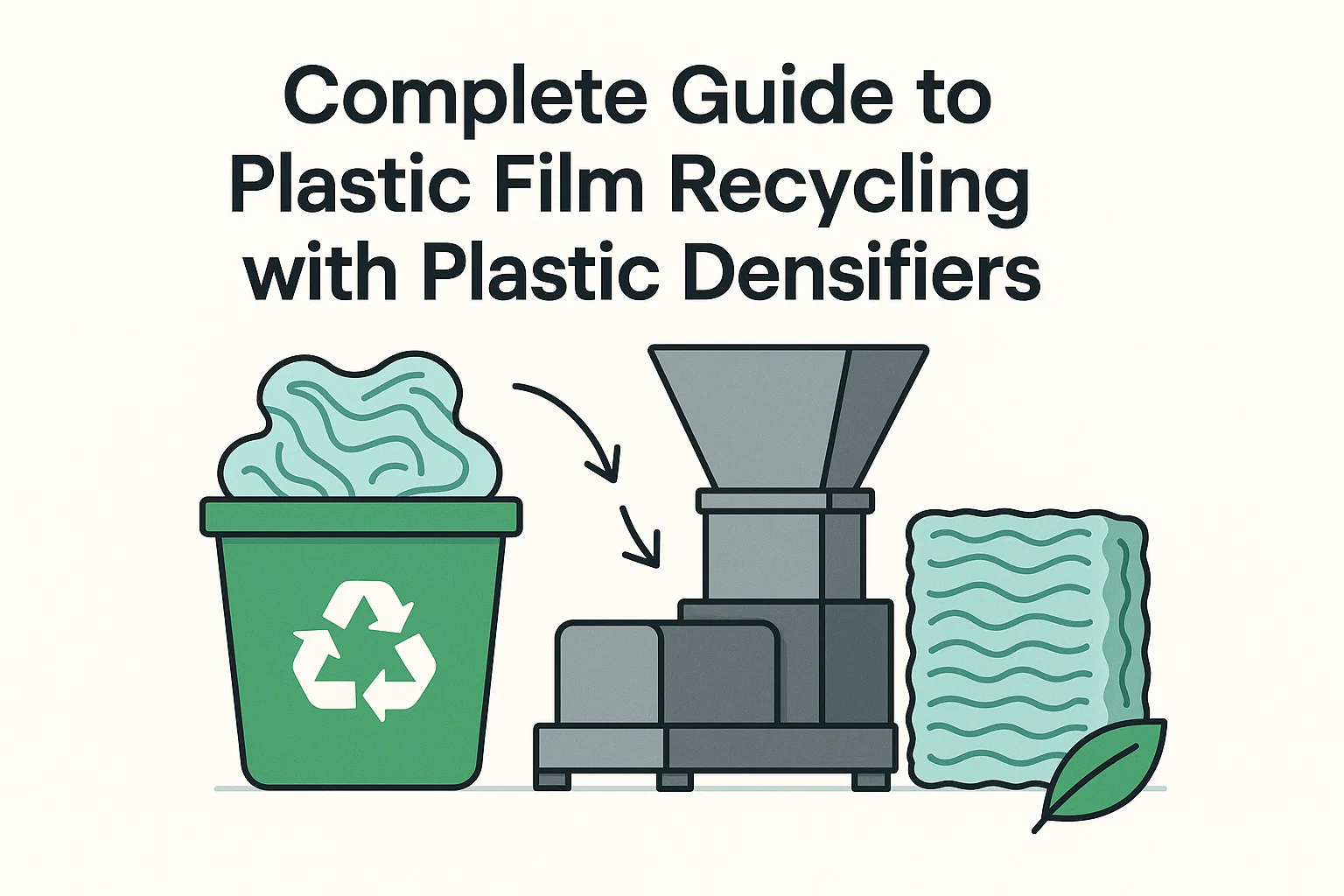Plastic film recycling is a cornerstone of sustainable manufacturing, transforming waste materials into valuable resources for industries across the USA and Europe. As global demand for eco-friendly practices grows, manufacturers, industrial recycling equipment buyers, and industry professionals are increasingly turning to advanced technologies to streamline their operations. At Energycle Machine, we specialize in providing cutting-edge solutions, including our industry-leading plastic densifiers, to optimize every stage of the recycling process. This article offers a comprehensive guide to the plastic film recycling workflow—shredding, washing, dewatering, densification, and pelletizing—while highlighting the critical role of plastic densifiers in achieving efficiency and quality. Tailored for professionals handling materials like PE (polyethylene), PP (polypropylene), LDPE (low-density polyethylene), HDPE (high-density polyethylene), and BOPP (biaxially oriented polypropylene), this guide ensures technical accuracy and actionable insights.
With stringent regulations like the EU’s Circular Economy Action Plan targeting 55% plastic recycling by 2030 and the USA’s push for improved waste management, understanding the full recycling process is vital. Energycle Machine’s expertise empowers businesses to meet these goals while maintaining cost-effectiveness and environmental responsibility.
Overview of the Plastic Film Recycling Process
Recycling plastic films involves a series of interconnected steps designed to convert bulky, lightweight waste into dense, reusable pellets. The process typically includes five key stages: shredding, washing, dewatering, densification, and pelletizing. Each stage requires specialized equipment to handle the unique properties of thermoplastic films, such as PE, PP, LDPE, HDPE, and BOPP. By integrating advanced machinery like Energycle Machine’s plastic densifiers, manufacturers can achieve high throughput, reduced waste, and compliance with regional standards.
Below, we break down each stage, illustrating workflows and comparing efficiency metrics to provide clarity for technical readers. This structured approach ensures a logical flow, making it easier to understand how plastic densifiers and other equipment contribute to a seamless recycling operation.
Step 1: Shredding – Breaking Down the Material
The recycling process begins with shredding, where plastic films are reduced into smaller, manageable pieces. This step is critical for preparing bulky materials for subsequent processing, as films are often received in rolls, bales, or loose forms.
Shredding Workflow
- Input: Semi-dry flakes (PE, PP, LDPE, HDPE, BOPP) enter the plastic densifier.
- Compression: Depending on the densifier type:
- Screw Press Densifier: A tapered screw applies pressure (40-50 rpm), squeezing out residual water (down to 3%) and forming dense granules.
- Agglomerator: High-speed blades (650-1050 rpm) generate frictional heat, softening films into granules.
- Output: Dense granules or agglomerates, with a bulk density increase of 30-50%, are ready for pelletizing.
Energycle Machine’s plastic densifiers, such as our Plastic Film Squeezer & Densifier System, feature advanced sensors to monitor temperature and pressure, preventing overheating and ensuring consistent output quality. This cutting-edge technology reduces moisture to as low as 1-5%, making it an ideal solution for high-efficiency recycling lines.
Key Considerations
- Efficiency: Shredders process 500-2000 kg/h, depending on material density and machine capacity.
- Pros: Reduces volume by up to 20%, facilitates downstream cleaning, and handles mixed plastics.
- Cons: Requires regular blade maintenance to prevent wear, especially with abrasive films like BOPP.
Step 2: Washing – Removing Contaminants
Washing is essential to remove dirt, labels, adhesives, and other contaminants from shredded films. Clean material ensures high-quality output in later stages, particularly during densification with a plastic densifier.
Washing Workflow
- Pre-Washing: Flakes enter a friction washer to remove loose debris.
- Main Wash: Hot or cold water, combined with detergents, is used in a high-speed washer (800-1200 rpm) to scrub contaminants.
- Rinsing: Clean water rinses residual chemicals, often in a secondary tank.
- Separation: Sink-float tanks or centrifugal separators remove non-plastic materials like paper or metal.
Energycle Machine’s washing systems incorporate energy-efficient pumps and filtration to recycle water, reducing operational costs and environmental impact.
Key Considerations
- Efficiency: Removes up to 99% of contaminants, critical for high-purity applications.
- Pros: Enhances material quality, prepares films for densification, and meets regulatory purity standards.
- Cons: High water usage (unless recycled) and potential for cross-contamination if not monitored.
Step 3: Dewatering – Removing Excess Moisture
Post-washing, plastic films retain significant moisture (up to 30-50%), which must be reduced before densification. Effective dewatering ensures optimal performance of plastic densifiers, preventing issues like material degradation or equipment clogging.
Dewatering Workflow
- Input: Wet flakes are fed into a dewatering machine, such as a centrifuge or screw press.
- Centrifugal Action: High-speed rotation (1500-2000 rpm) expels water through perforations, reducing moisture to 5-10%.
- Output: Semi-dry flakes are discharged for densification.
Energycle Machine’s dewatering units are engineered for high throughput, with automated controls to adjust spin speeds based on material type.
Key Considerations
- Efficiency: Achieves moisture levels suitable for plastic densifiers, typically below 10%.
- Pros: Reduces energy costs in subsequent stages, protects densifiers from water damage.
- Cons: May require secondary drying for very wet inputs, adding a process step.
Step 4: Densification – Compacting with Plastic Densifiers
Densification is a pivotal stage where plastic densifiers transform loose, low-density flakes into compact, high-density forms suitable for pelletizing. Energycle Machine’s plastic densifiers, including screw press densifiers and agglomerators, are designed to handle a range of films, ensuring versatility and efficiency.
Densification Workflow
- Input: Semi-dry flakes (PE, PP, LDPE, HDPE, BOPP) enter the plastic densifier.
- Compression: Depending on the densifier type:
- Screw Press Densifier: A tapered screw applies pressure (40-50 rpm), squeezing out residual water (down to 3%) and forming dense granules.
- Agglomerator: High-speed blades (650-1050 rpm) generate frictional heat, softening films into granules.
- Output: Dense granules or agglomerates, with a bulk density increase of 30-50%, are ready for pelletizing.
Energycle Machine’s plastic densifiers feature advanced sensors to monitor temperature and pressure, preventing overheating and ensuring consistent output quality.
Key Considerations
- Efficiency: Plastic densifiers achieve a compression ratio of up to 1:50, significantly reducing volume.
- Pros: Enhances material handling, reduces transportation costs, and prepares high-quality input for pelletizing.
- Cons: Equipment choice depends on moisture content and desired output form (granules vs. blocks).
Step 5: Pelletizing – Creating Reusable Pellets
The final stage, pelletizing, converts densified material into uniform pellets suitable for manufacturing new products. This step ensures the recycled plastic meets industry standards for applications like extrusion or injection molding.
Pelletizing Workflow
- Input: Dense granules from the plastic densifier are fed into an extruder.
- Melting: Material is heated (180-250°C) and extruded through a die, forming strands.
- Cutting: Strands are cooled and cut into pellets (2-5 mm) using a pelletizer.
- Collection: Pellets are stored or packaged for sale or reuse.
Energycle Machine’s pelletizing systems offer precise temperature control to prevent material degradation, ensuring high-quality pellets for PE, PP, and other films.
Key Considerations
- Efficiency: Produces 300-1000 kg/h of uniform pellets, depending on extruder size.
- Pros: Creates market-ready material, closes the recycling loop, and meets quality standards.
- Cons: Requires precise calibration to avoid inconsistent pellet sizes.
Comparative Efficiency of the Recycling Process
To illustrate the impact of each stage, here’s a comparison of key metrics, emphasizing the role of plastic densifiers:
| Stage | Purpose | Output Characteristics | Efficiency Metrics |
|---|---|---|---|
| Shredding | Size reduction | Flakes (10-50 mm) | 500-2000 kg/h, 20% volume reduction |
| Washing | Contaminant removal | Clean flakes | 99% contaminant removal |
| Dewatering | Moisture reduction | Semi-dry flakes (5-10% moisture) | Reduces moisture for densification |
| Densification | Volume reduction, densification | Dense granules (30-50% density increase) | 1:50 compression, 500-1000 kg/h |
| Pelletizing | Final product formation | Uniform pellets (2-5 mm) | 300-1000 kg/h, high market value |
Plastic densifiers are the linchpin, bridging washing and pelletizing by ensuring material is compact and dry, optimizing downstream processes. Energycle Machine’s plastic densifiers are tailored to handle diverse inputs, making them ideal for both USA and European operations.
Visualizing the Workflow
For technical clarity, here’s a simplified workflow diagram of the recycling process:
- Shredding: Bales → Shredder → Flakes
- Washing: Flakes → Friction Washer → Rinse Tank → Clean Flakes
- Dewatering: Wet Flakes → Centrifuge/Screw Press → Semi-Dry Flakes
- Densification: Flakes → Plastic Densifier → Dense Granules
- Pelletizing: Granules → Extruder → Pelletizer → Pellets
This streamlined process, powered by Energycle Machine’s equipment, ensures minimal waste and maximum efficiency.
FAQ: Common Questions About Plastic Film Recycling
What types of plastics can be processed in this workflow?
The process handles PE, PP, LDPE, HDPE, BOPP, and similar thermoplastics, including films, bags, and non-woven materials. Energycle Machine’s plastic densifiers are versatile for various inputs.
How critical is the plastic densifier in the recycling process?
The plastic densifier is essential for reducing volume and preparing material for pelletizing, cutting transportation costs and ensuring high-quality pellets. It’s a game-changer for efficiency.
What are the energy costs of the full process?
Shredding and pelletizing consume the most energy due to mechanical and thermal demands, but Energycle Machine’s plastic densifiers and dewatering units are designed for low power usage, optimizing overall costs.
Can this process handle post-consumer films?
Yes, with proper washing and sorting, post-consumer films can be processed. Our plastic densifiers excel at handling variable inputs, ensuring consistent output.
Conclusion: Transform Your Recycling with Energycle Machine
The plastic film recycling process—shredding, washing, dewatering, densification, and pelletizing—offers a robust solution for manufacturers aiming to meet sustainability goals in the USA and Europe. At the heart of this process, Energycle Machine’s plastic densifiers deliver unmatched efficiency, reducing volume and preparing high-quality material for pelletizing. Our commitment to innovation and technical excellence ensures your recycling operations are both cost-effective and environmentally responsible.
Ready to revolutionize your recycling line? Contact Energycle Machine today to explore our advanced plastic densifiers and other equipment. Request a quote or schedule a consultation via our website to start transforming waste into opportunity!



